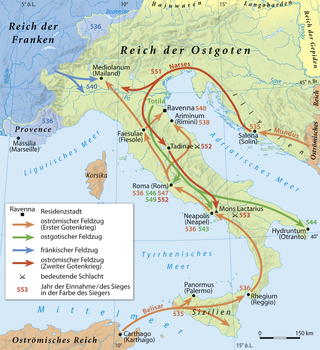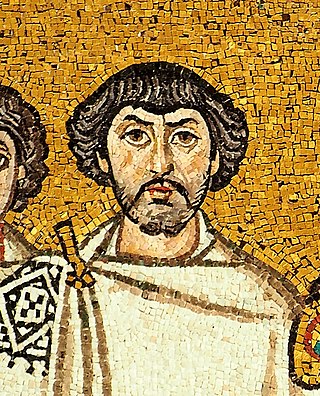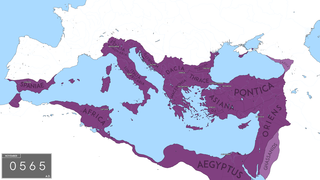Year 538 (DXXXVIII) was a common year starting on Friday of the Julian calendar. At the time, it was known as the Year of the Consulship of Iohannes without colleague. The denomination 538 for this year has been used since the early medieval period, when the Anno Domini calendar era became the prevalent method in Europe for naming years.

The Battle of Ad Decimum took place on September 13, 533 between the armies of the Vandals, commanded by King Gelimer, and the Byzantine Empire, under the command of General Belisarius. This event and events in the following year are sometimes jointly referred to as the Battle of Carthage, one of several battles to bear that name. The Byzantine victory marked the beginning of the end for the Vandals and began the reconquest of the west under the Emperor Justinian I.

Narses was, with Belisarius, one of the great generals in the service of the Byzantine Emperor Justinian I during the Roman reconquest that took place during Justinian's reign. Narses was a Romanized Armenian. He spent most of his life as an important eunuch in the palace of the emperors in Constantinople.

Totila, original name Baduila, was the penultimate King of the Ostrogoths, reigning from 541 to 552 AD. A skilled military and political leader, Totila reversed the tide of the Gothic War, recovering by 543 almost all the territories in Italy that the Eastern Roman Empire had captured from his Kingdom in 540.

The Gothic War between the Eastern Roman Empire during the reign of Emperor Justinian I and the Ostrogothic Kingdom of Italy took place from 535 to 554 in the Italian Peninsula, Dalmatia, Sardinia, Sicily and Corsica. It was one of the last of the many Gothic Wars against the Roman Empire. The war had its roots in the ambition of the Eastern Roman (Byzantine) Emperor Justinian I to recover the provinces of the former Western Roman Empire, which the Romans had lost to invading barbarian tribes in the previous century, during the Migration Period.
The First Siege of Rome during the Gothic War lasted for a year and nine days, from 2 March 537 to 12 March 538. The city was besieged by the Ostrogothic army under their king Vitiges; the defending East Romans were commanded by Belisarius, one of the most famous and successful Roman generals. The siege was the first major encounter between the forces of the two opponents, and played a decisive role in the subsequent development of the war.

The Battle of Sena Gallica, was a naval battle fought off the Italian Adriatic coast in the autumn of 551 between an East Roman (Byzantine) and an Ostrogoth fleet, during the Gothic War (535–554). It marked the end of the Goths' brief bid to deny the seas to the Romans, and the beginning of the Byzantine resurgence in the war under the leadership of Narses.
Sittas was a Byzantine military commander during the reign of Emperor Justinian I. During the Iberian War against the Sassanid Empire, Sittas was given command of forces in Armenia, similar to the status of Belisarius in Mesopotamia. He won a victory over the Sassanids at the battle of Satala.

Belisarius was a military commander of the Byzantine Empire under the emperor Justinian I. He was instrumental in the reconquest of much of the Mediterranean territory belonging to the former Western Roman Empire, which had been lost less than a century prior.

The Byzantine Empire underwent a golden age under the Justinian dynasty, beginning in 518 AD with the accession of Justin I. Under the Justinian dynasty, particularly the reign of Justinian I, the empire reached its greatest territorial extent since the fall of its Western counterpart, reincorporating North Africa, southern Illyria, southern Spain, and Italy into the empire. The Justinian dynasty ended in 602 with the deposition of Maurice and the ascension of his successor, Phocas.
Aratius was an Armenian military commander of the 6th century whose brother was Narses. He served at first the Sasanian Empire, then defected to the Byzantine Empire. He is primarily known for his activities in the Iberian War and the Gothic War. He was eventually killed in an ambush. Primary sources about him include Choricius of Gaza and Procopius of Caesarea.
Justin was a 6th-century East Roman (Byzantine) general, who was active in the Gothic War in Italy under Justinian I.
John, the nephew of the rebel Vitalian, was an Eastern Roman general under Justinian I, who was active in the Gothic War in Italy and against the Gepids in the western Balkans. He was married to Justina, the daughter of Justinian's cousin Germanus.
Bessas was an Eastern Roman general of Gothic origin from Thrace, primarily known for his career in the wars of Justinian I. He distinguished himself against the Sassanid Persians in the Iberian War and under the command of Belisarius in the Gothic War, but after Belisarius' departure from Italy he failed to confront the resurgent Goths and was largely responsible for the loss of Rome in 546. Returning east in disgrace, despite his advanced age he was appointed as commander in the Lazic War. There he redeemed himself with the recapture of Petra, but his subsequent idleness led Justinian to dismiss him and exile him to Abasgia.
The siege of Naples in 536 was a successful siege of Naples by the Eastern Roman Empire under Belisarius during the Gothic War.
The siege of Auximus was a siege during Justinian’s Gothic War which took place in the year 539. It ended with Belisarius’ Byzantine force victorious. The Gothic garrison surrendered the town and joined the Byzantines after negotiations. The siege lasted 7 months.
The siege of Ariminum also referred to as the siege of Rimini was fought between Byzantine forces under Belisarius and John and an Ostrogothic force. The Goths lifted the siege after Belisarius approached with multiple forces from multiple angles. He also had his men light extra camp fires, this way it seemed to the besieging Goths like a large force was approaching them.
The siege of Urviventus or siege of Urbs Vetus took place during Justinian I's Gothic War. The Byzantine commander Belisarius dispatched a strong force to take Urviventus, himself marching on Urbinus. 1,000 Goths under Albilas had been sent to defend the city. Belisarius, after capturing Urbinus, reinforced the besieging army. He assessed the situation, deciding the town could not be taken by storm. When the town ran out of supplies the defenders surrendered.
The siege of Ravenna of 539-540 took place during Justinian’s Gothic War.
The siege of Sisauranon took place in 541 between Byzantine forces under Belisarius and the Sassanian garrison of the Sisauranon fortress under Bleschames.






